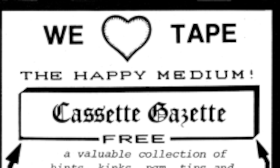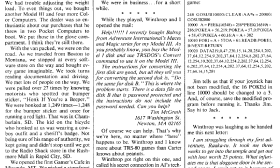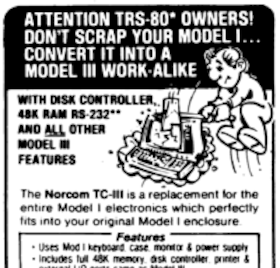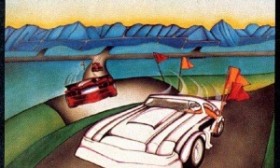From page 6 of the Cassette Gazette:
When a program tape develops a fault it is usually called a “hit”. One common type is a “switch hit”, which is a sharp spike of noise placed on the tape when the motor current stops suddenly. If you switch off your recorder in the middle of a program, or if the program bombs and the computer turns the recorder off, any switch hit that occurs will make that copy forever unloadable. A capacitor or diode or both across the CTR motor can help this problem… but we, of course, think we offer a better solution.
The SOFTROL is a solid state switch that has a built-in one-second motor off delay. The power to the motor is reduced slowly to bring it to a “soft” stop, instead of cutting it off abruptly.
(Read more...)
“The Gamer’s Cafe” was a column about TRS-80 gaming which ran in 80 Micro magazine. It first appeared in the November 1982 issue near the height of the TRS-80 game market and ran until April 1984. “The Gamer’s Cafe” had some similarities to “Captain 80,” a column written by Bob Liddil that premiered in the first issue of 80 Microcomputing in 1980 and later appeared in 80-U.S. Journal.
With only a few exceptions, “The Gamer’s Cafe” was written by the fictional character of Rodney Gambicus. The column started when Rodney and his friend Winthrop Luzerdraw decided to travel the country in a Ford Econoline van. They filled the van with TRS-80 computers and games, including multiple Model I’s, Model III’s, Color Computers, and two Pocket Computers that the Radio Shack dealer threw in as part of the deal. They also had a PMC-80 which they described as a “PMC ½.” Their plan was to stop at various locations around the country, put out tables, and let people play TRS-80 games, literally a “Gamer’s Cafe.”
(Read more...)
From page 5 of the Cassette Gazette:
What’s a loader? As WE use the term, it means a hardware unit that plugs between the cassette recorder and the computer. Its job is to make tape loading reliable… BASIC, SYSTEM, KWIK or whatever.
(Read more...)
From page 4 of the Cassette Gazette:
Another cause of wow is a defective motor. You can often detect this with a little rough stuff. While listening to a tape, tap the motor smartly with a screwdriver handle… if you get a bug increase in wow you may have a bad motor. Replace or repair the motor? Unless you can do the repair yourself, or have access to the correct new motor, you probably should just do yourself a favor and go buy a new CTR.
(Read more...)
From page 3 of the Cassette Gazette:
Although you may not know exactly what it means, you have probably heard of a “head adjustment” or “azimuth” setting. There is a very narrow gap (vertical slit) in the record head that records the signal on the magnetic (oxide) coating on the tape. Essentially, ‘azimuth' is the angle that this gap makes to the direction of the tape movement. (See Fig 1.) The ideal is for the gap to be aligned at exactly a right angle (90 degrees) in reference to the direction of tape movement.
(Read more...)
From page 2 of the Cassette Gazette:
Many mysteries and surprises lay in wait for the computer cassette-user. Early on we were surprised to find that high-quality (and high priced) music tapes in general, and even some of the expensive “certified” computer tapes in particular, are inferior to some 25-cent ‘cheapies'. The fact is that the loading performance of a tape cannot be predicted from its cost. Also, good and bad tapes are like bananas… they come in bunches.
(Read more...)
The Cassette Gazette was a 1983 one issue advertising newsletter that was a joint production of Lemons Tech and KWIK Software. The Gazette described the products sold by the two companies, mixed in with operational advice and interesting facts about using cassettes with your TRS-80. It appears to have been written by Wayne Lemons, the founder of Lemons Tech. The Gazette is reproduced here page by page with permission from Wayne Lemons' family.
(Read more...)
The Model III added some nice improvements to the Model I and boasted nearly complete compatibility. But there were still some areas of incompatibility. Considering that most TRS-80 software development moved to the Model III, it was understandable that some Model I owners felt left behind.
The Norcom TC-III was a $399.00 ($499.00 factory installed) motherboard replacement for the Model I that promised all Model III features right in the Model I case. It was sold by Northern Information Technology Corp. The advertisements touted the following features:
(Read more...)
Rally was written by J. Weaver Jr. (Factory Programming) and distributed by Soft Sector Marketing. Rally was based on Rally-X, which was released by Namco in 1980.
The goal in Rally is to collect all of the flags in a maze, while avoiding “enemy cars”. Touching an enemy car causes you to lose your life.
(Read more...)
This somewhat alarming warning appeared in the June 1980 issue of 80-U.S. Journal:
The video controller of the Model II is mapped to I/O port 255 (FFH). If an output is made to this port with a value of less than 25, there is a very good chance that YOUR VIDEO WILL BE DESTROYED! We don’t know why this happens yet, but we do know that about a dozen of them across the country have been blown in this fashion, resulting in an expensive repair bill. If for any reason your screen should go blank unexpectedly, accompanied by a very high-pitched whining noise, you have less than 7 seconds to TURN THE COMPUTER OFF! Don’t worry about having disks in the drives or anything. Even the data you lose is cheap compared to having to do without a computer while it is being repaired.
(Read more...)








